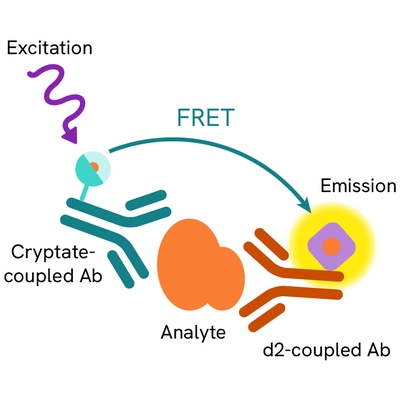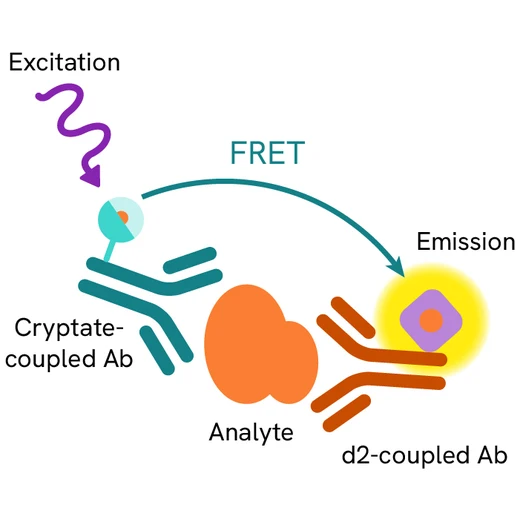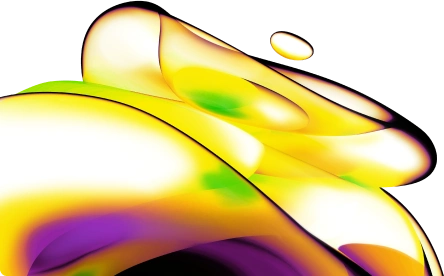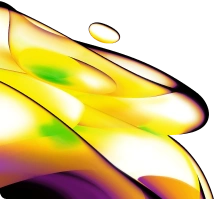

HTRF Glucagon Serum Detection Kit, 200 Assay Points








| Feature | Specification |
|---|---|
| Application | Protein Quantification |
| Sample Volume | 10 µL |









Product information
Overview
The Glucagon offers superior specificity and sensitivity for a reliable quantification of glucagon in serum and plasma samples. Built on a truly homogeneous protocol, the assay does not require any washing or complex extraction steps, meaning significant time savings over ELISA methods. Simply add the detection reagents, incubate, and read!
How it works
Assay principle
Glucagon is measured using a sandwich immunoassay with two monoclonal antibodies, one labelled with Lumi4-Tb Cryptate (donor) and the other with d2 (acceptor). The intensity of the FRET signal obtained is proportional to the concentration of glucagon in the sample.

Assay protocol
10 µL of cell supernatants are supplemented with 5 µL of acceptor-labelled antibodies and 5 µL of donor-labelled antibodies (or 10 µL of pre-mixed reagents for a single dispensing step). The mix is then incubated from 4h to overnight at RT and results are read on an HTRF compatible reader.

Assay details
Specificity
| Peptide | Specificity ( % of recognition ) |
|---|---|
| Glucagon | 100% |
| Oxyntomodulin | <0.07% |
| Glicentin | <0.07% |
| Glucagon fragment 1-18 | <1.81% |
| Glucagon fragment 19-29 | <0.03% |
| GLP-1 (7-36) amide | <0.06% |
| GLP-1 (7-37) | <0.11% |
| GLP-2 | <0.3% |
| GRPP (Glicentin-Related Pancreatic Peptide) | <0.01% |
Sensitivity
Typical calibration curves obtained by the dilution of glucagon standard in cell-culture media conditions for 20 µL final, using a white 384-well small volume plate, are presented below. Samples were incubated overnight at RT and diluted in diluent #6. The assay ranges from 15,6 to 2000 pg/mL and the detection limit measured was 12 pg/mL (PHERAstar FS reader - flash lamp excitation).

Linearity
Dilution linearity in cell culture media was assessed, with recovery results between 100% and 117%. Human serum samples were collected and serially diluted in diluent #6. The results are expressed as percent observed from expected.

Serial dilutions of a human serum sample in diluent #6: Human serum sample [Glucagon] measured (pg/mL) [Glucagon] expected (pg/mL) % of expected concentration Undiluted 1666.7 - - 1:2 846.3 833.3 101.6 % 1:4 420.7 416.7 101.0 % 1:8 221.7 208.3 106.4 % 1:16 121.8 104.2 116.9 %
Intra- and inter-assay variability
Intra-assay and inter-assay variability in cell culture media conditions were assessed. Typical CVs of less than 4% for intra- and less than or around 10% for inter- were obtained, supporting claims regarding the features of a robust and reproducible assay.
| Intra-Assay - n = 24 | CV |
|---|---|
| Standard 2 (= 31.25 pg/mL) | 1.8% |
| Standard 6 (= 500 pg/mL) | 1.9% |
| Standard 8 (= 2,000 pg/mL) | 3.6% |
| Intra-Assay - n = 6 | CV |
|---|---|
| Standard 2 (= 31.25 pg/mL) | 11.2% |
| Standard 6 (= 500 pg/mL) | 6.6% |
| Standard 8 (= 2,000 pg/mL) | 6.4% |
Assay validation
Normal and pathological levels of glucagon
Glucagon concentrations for 16 pathological and normal EDTA-plasma samples were determined using the HTRF Serum Glucagon kit reagents. The results obtained show the good discrimination of the glucagon assay, clearly differentiating between normal and pathological levels of glucagon.

Specifications
| Application |
Protein Quantification
|
|---|---|
| Brand |
HTRF
|
| Detection Modality |
HTRF
|
| Product Group |
Kit
|
| Sample Volume |
10 µL
|
| Shipping Conditions |
Shipped in Dry Ice
|
| Target Class |
Biomarkers
|
| Technology |
TR-FRET
|
| Therapeutic Area |
Metabolism/Diabetes
|
| Unit Size |
200 assay points
|
Video gallery
Resources
Are you looking for resources, click on the resource type to explore further.
Helping you select an optimal assay for your research
Revvity offers a comprehensive line of insulin quantification assays designed...
Discover the versatility and precision of Homogeneous Time-Resolved Fluorescence (HTRF) technology. Our HTRF portfolio offers a...
This guide provides you an overview of HTRF applications in several therapeutic areas.


Loading...
How can we help you?
We are here to answer your questions.






























